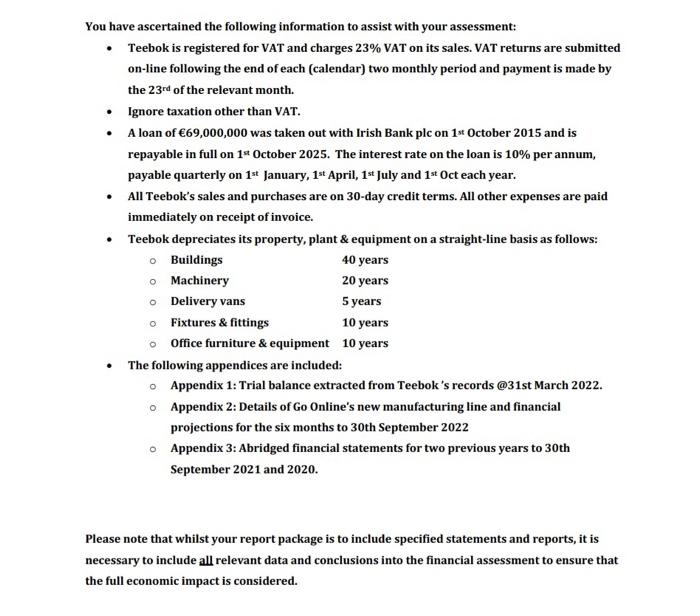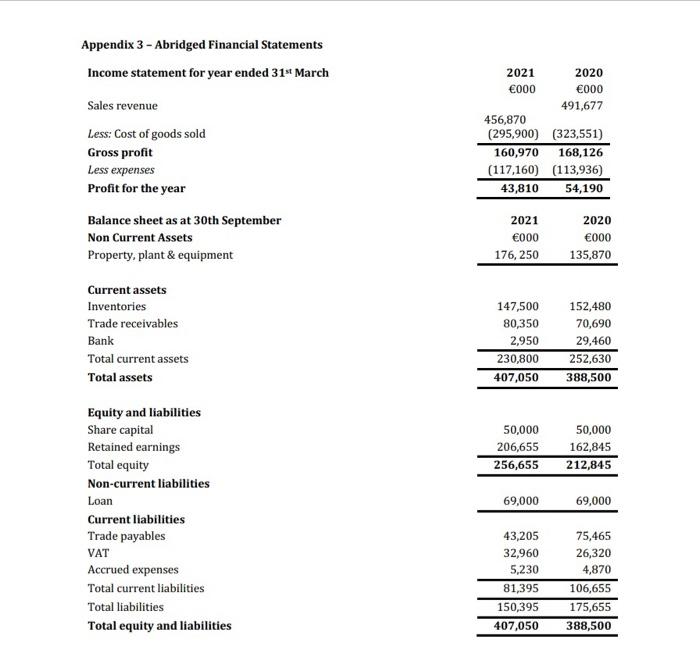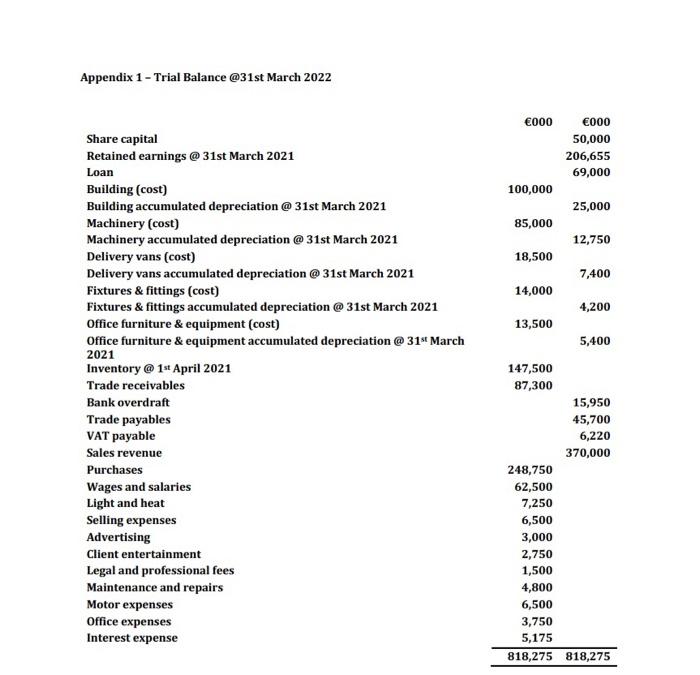Prepare
1. A forecast trading profit for the six months ended 30th September 2022, in contribution form 2. Cash forecast for the six months ended 30th September 2022.
Notes:
A. Teebok is registered for VAT and charges 23% VAT on its sales. VAT returns are submitted online following the end of each (calendar) two month period and payment is made by the 23rd of the relevant month.
B. Ignore taxation other than VAT
C. A loan of 69,000,000 was taken out with the AIB plc on 1st October 2015 and is repayable in full on 1st October 2025. The interest rate on the loan is 10% per annum, payable quarterly on 1st January, 1st April, 1st July and 1st October each year.
D. All teebok's sales and purchases are on 30-day credit terms. All other expenses are paid immediately on receipt of invoice.
E. Teebok depreciates its property, plant & equipment on a straight-line basis as follows:
-Buildings (40 years)
-Machinery (20 years)
-Delivery Vans (5 years)
-Fixture & Fittings (10 years)
-Office furniture & equipment (10 years)
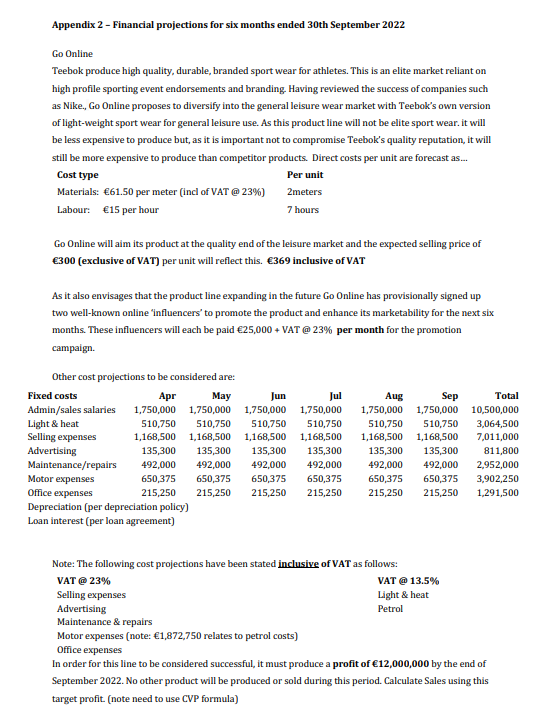
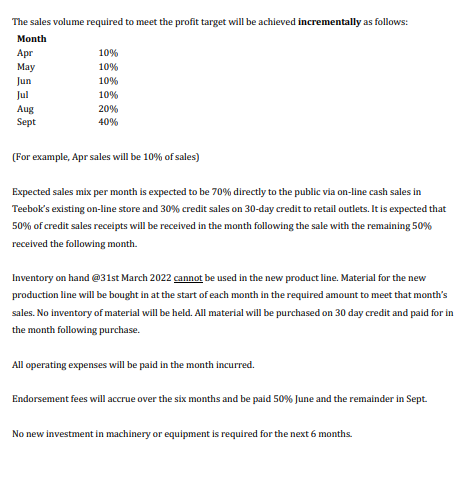
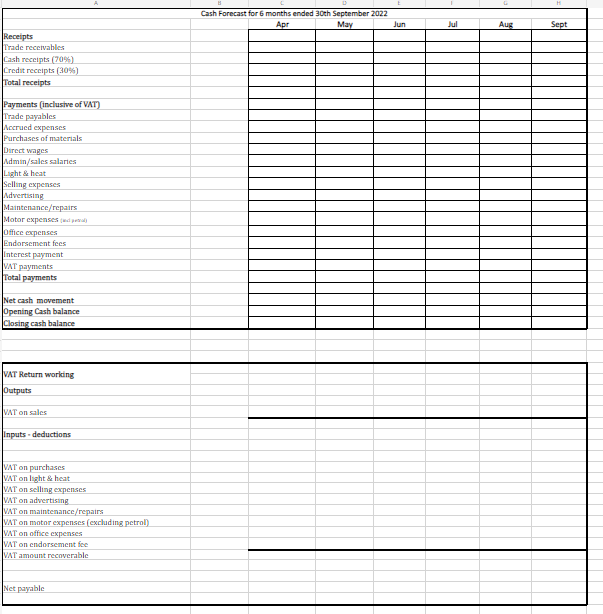
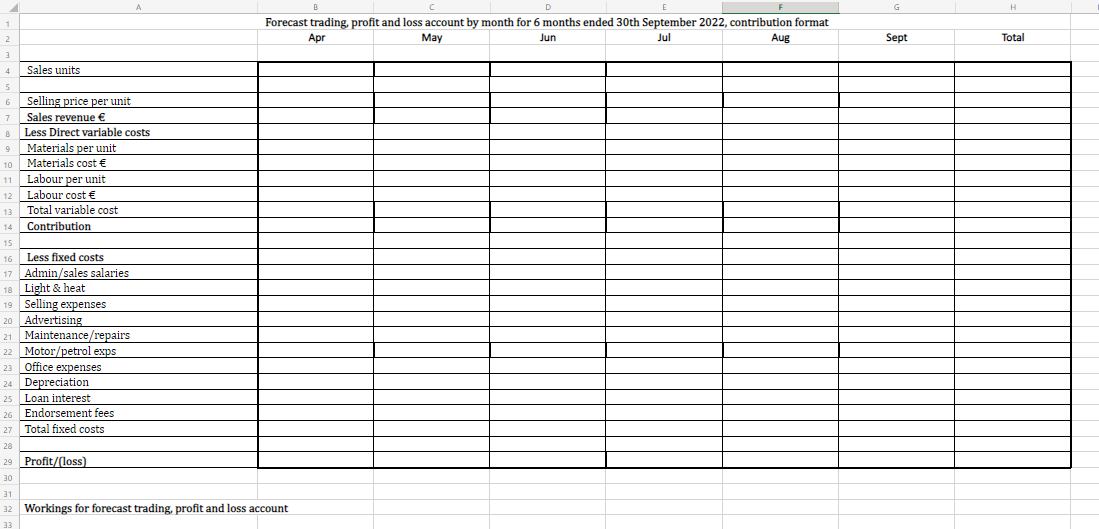
Appendix 2 - Financial projections for six months ended 30th September 2022 Go Online Teebok produce high quality, durable, branded sport wear for athletes. This is an elite market reliant on high profile sporting event endorsements and branding. Having reviewed the success of companies such as Nike., Go Online proposes to diversify into the general leisure wear market with Teebok's own version of light-weight sport wear for general leisure use. As this product line will not be elite sport wear. it will be less expensive to produce but, as it is important not to compromise Teebok's quality reputation, it will still be more expensive to produce than competitor products. Direct costs per unit are forecast as... Cost type Per unit Materials: 61.50 per meter (incl of VAT @ 23%) 2meters Labour: 15 per hour 7 hours Go Online will aim its product at the quality end of the leisure market and the expected selling price of 300 (exclusive of VAT) per unit will reflect this. 369 inclusive of VAT As it also envisages that the product line expanding in the future Go Online has provisionally signed up two well-known online influencers' to promote the product and enhance its marketability for the next six months. These influencers will each be paid 25,000 + VAT @ 23% per month for the promotion campaign. Other cost projections to be considered are: Fixed costs Apr May Admin/sales salaries 1,750,000 1,750,000 Light & heat 510,750 510,750 Selling expenses 1,168,500 1,168,500 Advertising 135,300 135,300 Maintenance/repairs 492,000 492,000 Motor expenses 650,375 650,375 Office expenses 215,250 215,250 Depreciation (per depreciation policy) Loan interest (per loan agreement) Jun 1,750,000 510,750 ,168,500 135,300 492,000 650,375 215,250 Jul 1,750,000 510,750 1,168,500 135,300 492,000 650,375 215,250 Aug 1,750,000 510,750 1,168,500 135,300 492,000 650,375 215,250 Sep Total 1,750,000 10,500,000 510,750 3,064,500 1,168,500 7,011,000 135,300 811,800 492,000 2,952,000 650,375 3,902,250 215,250 1,291,500 Note: The following cost projections have been stated inclusive of VAT as follows: VAT @ 23% VAT @ 13.5% Selling expenses Light & heat Advertising Petrol Maintenance & repairs Motor expenses (note: 1,872,750 relates to petrol costs) Office expenses In order for this line to be considered successful, it must produce a profit of 12,000,000 by the end of September 2022. No other product will be produced or sold during this period. Calculate Sales using this target profit. (note need to use CVP formula) The sales volume required to meet the profit target will be achieved incrementally as follows: Month Apr 10% May 10% Jun 10% Jul 10% Aug 20% Sept 40% (For example, Apr sales will be 10% of sales) Expected sales mix per month is expected to be 70% directly to the public via on-line cash sales in Teebok's existing on-line store and 30% credit sales on 30-day credit to retail outlets. It is expected that 50% of credit sales receipts will be received in the month following the sale with the remaining 50% received the following month. Inventory on hand @31st March 2022 cannot be used in the new product line. Material for the new production line will be bought in at the start of each month in the required amount to meet that month's sales. No inventory of material will be held. All material will be purchased on 30 day credit and paid for in the month following purchase. All operating expenses will be paid in the month incurred. Endorsement fees will accrue over the six months and be paid 50% June and the remainder in Sept No new investment in machinery or equipment is required for the next 6 months. Cash Forecast for 6 months ended 30th September 2022 Apr May Jun Jul Aug Sept Receipts Trade receivables Cash receipts (70%) Credit receipts (20%) Total receipts Payments (inclusive of VAT) trade payables Accrued expenses Purchases of materials Direct wages Admin/sales salaries Light & heat Selling expenses Advertising Maintenance/repairs Motor expenses Office expenses Endorsement fees Interest payment VAT payments Total payments Net cash movement Opening Cash balance Closing cash balance VAT Return working Outputs VAT on sales inputs. deductions VAT on purchases VAT on light & heat VAT on selling expenses VAT on advertising VAT on maintenance/repairs WAT on motor expenses (excluding petrol) VAT on office expenses WAT on endorsement fee VAT amount recoverable Net payable A H 1 Forecast trading profit and loss account by month for 6 months ended 30th September 2022, contribution format Apr May Jun Jul Aug 2 Sept Total 3 4 Sales units 5 6 Selling price per unit 7 Sales revenue B Less Direct variable costs 9 Materials per unit 10 Materials cost 11 Labour per unit 12 Labour cost 13 Total variable cost 14 Contribution 15 16 Less fixed costs 17 Admin/sales salaries 18 Light & heat 19 Selling expenses 20 Advertising Maintenance/repairs 22 Motor/petrol exps 23 Office expenses 24 Depreciation 25 Loan interest 26 Endorsement fees 27 Total fixed costs 28 29 Profit/loss 20 21 12 Workings for forecast trading, profit and loss account 21 33 TEEBOK COMPANY CASE STUDY (75 marks) Teebok Co. is an Irish sportswear manufacturer. It has recently seen a decline in profitability owing to Covid 19. As a result, Teebok is faced with having to suspend its operations immediately unless it can find alternative markets to ensure the business can remain operational. The window to implement a new plan is very tight. Luckily, the production and sales directors had already assembled a team to devise a plan, referred to as 'Go Online,' to diversify the business away from its reliance on the direct retail market. While much of the outline of Go Online is ready, it still requires input from the finance department. Although the team had intended to present Go Online at a strategy conference planned for later this year, events have now overtaken them and an emergency meeting of Teebok's senior management team has been called for next week. The principle agenda items are an assessment of the current level of stress on the firm's liquidity and a discussion of the proposed Go Online which, it is hoped, can go into production quickly. To assist with these discussions, you are required to prepare a financial report package for the meeting regarding Teebok's current liquidity condition and the expected financial implications of the Go Online proposal under consideration. Your report package must include the following: 1. Trading, profit and loss account and balance sheet 31st March 2022 (20 m) 2. Forecast trading profit and loss for the six months ended 30th September 2022, in contribution form. (20 m) 3. Cash forecast for the six months ended 30th September 2022. (20m) 4. Evaluation of Teebok 's liquidity position and recommendations to improve it. (15 m) You have ascertained the following information to assist with your assessment: Teebok is registered for VAT and charges 23% VAT on its sales. VAT returns are submitted on-line following the end of each (calendar) two monthly period and payment is made by the 23rd of the relevant month. Ignore taxation other than VAT. A loan of 69,000,000 was taken out with Irish Bank plc on 1st October 2015 and is repayable in full on 1* October 2025. The interest rate on the loan is 10% per annum, payable quarterly on 15 January, 1st April, 1* July and 1st Oct each year. All Teebok's sales and purchases are on 30-day credit terms. All other expenses are paid immediately on receipt of invoice. Teebok depreciates its property, plant & equipment on a straight-line basis as follows: o Buildings 40 years o Machinery 20 years o Delivery vans 5 years o Fixtures & fittings 10 years o Office furniture & equipment 10 years The following appendices are included: o Appendix 1: Trial balance extracted from Teebok's records @31st March 2022. Appendix 2: Details of Go Online's new manufacturing line and financial projections for the six months to 30th September 2022 Appendix 3: Abridged financial statements for two previous years to 30th September 2021 and 2020. Please note that whilst your report package is to include specified statements and reports, it is necessary to include all relevant data and conclusions into the financial assessment to ensure that the full economic impact is considered. Appendix 3 - Abridged Financial Statements Income statement for year ended 31st March Sales revenue Less: Cost of goods sold Gross profit Less expenses Profit for the year 2021 2020 000 000 491,677 456,870 (295,900) (323,551) 160,970 168,126 (117,160) (113,936) 43,810 54,190 Balance sheet as at 30th September Non Current Assets Property, plant & equipment 2021 000 176, 250 2020 000 135,870 Current assets Inventories Trade receivables Bank Total current assets Total assets 147,500 80,350 2,950 230,800 407,050 152,480 70,690 29,460 252,630 388,500 50,000 206,655 256,655 50,000 162,845 212,845 69,000 69,000 Equity and liabilities Share capital Retained earnings Total equity Non-current liabilities Loan Current liabilities Trade payables VAT Accrued expenses Total current liabilities Total liabilities Total equity and liabilities 43,205 32,960 5,230 81,395 150,395 407,050 75,465 26,320 4,870 106,655 175,655 388,500 Appendix 1 - Trial Balance @31st March 2022 000 000 50,000 206,655 69,000 100,000 25,000 85,000 12,750 18,500 7,400 14,000 4,200 13,500 5,400 Share capital Retained earnings @31st March 2021 Loan Building (cost) Building accumulated depreciation @31st March 2021 Machinery (cost) Machinery accumulated depreciation @31st March 2021 Delivery vans (cost) Delivery vans accumulated depreciation @31st March 2021 Fixtures & fittings (cost) Fixtures & fittings accumulated depreciation @31st March 2021 Office furniture & equipment (cost) Office furniture & equipment accumulated depreciation @31" March 2021 Inventory @ 1st April 2021 Trade receivables Bank overdraft Trade payables VAT payable Sales revenue Purchases Wages and salaries Light and heat Selling expenses Advertising Client entertainment Legal and professional fees Maintenance and repairs Motor expenses Office expenses Interest expense 147,500 87,300 15,950 45,700 6,220 370,000 248,750 62,500 7,250 6,500 3,000 2,750 1,500 4,800 6,500 3,750 5,175 818,275 818,275 Appendix 2 - Financial projections for six months ended 30th September 2022 Go Online Teebok produce high quality, durable, branded sport wear for athletes. This is an elite market reliant on high profile sporting event endorsements and branding. Having reviewed the success of companies such as Nike., Go Online proposes to diversify into the general leisure wear market with Teebok's own version of light-weight sport wear for general leisure use. As this product line will not be elite sport wear. it will be less expensive to produce but, as it is important not to compromise Teebok's quality reputation, it will still be more expensive to produce than competitor products. Direct costs per unit are forecast as... Cost type Per unit Materials: 61.50 per meter (incl of VAT @ 23%) 2meters Labour: 15 per hour 7 hours Go Online will aim its product at the quality end of the leisure market and the expected selling price of 300 (exclusive of VAT) per unit will reflect this. 369 inclusive of VAT As it also envisages that the product line expanding in the future Go Online has provisionally signed up two well-known online influencers' to promote the product and enhance its marketability for the next six months. These influencers will each be paid 25,000 + VAT @ 23% per month for the promotion campaign. Other cost projections to be considered are: Fixed costs Apr May Admin/sales salaries 1,750,000 1,750,000 Light & heat 510,750 510,750 Selling expenses 1,168,500 1,168,500 Advertising 135,300 135,300 Maintenance/repairs 492,000 492,000 Motor expenses 650,375 650,375 Office expenses 215,250 215,250 Depreciation (per depreciation policy) Loan interest (per loan agreement) Jun 1,750,000 510,750 ,168,500 135,300 492,000 650,375 215,250 Jul 1,750,000 510,750 1,168,500 135,300 492,000 650,375 215,250 Aug 1,750,000 510,750 1,168,500 135,300 492,000 650,375 215,250 Sep Total 1,750,000 10,500,000 510,750 3,064,500 1,168,500 7,011,000 135,300 811,800 492,000 2,952,000 650,375 3,902,250 215,250 1,291,500 Note: The following cost projections have been stated inclusive of VAT as follows: VAT @ 23% VAT @ 13.5% Selling expenses Light & heat Advertising Petrol Maintenance & repairs Motor expenses (note: 1,872,750 relates to petrol costs) Office expenses In order for this line to be considered successful, it must produce a profit of 12,000,000 by the end of September 2022. No other product will be produced or sold during this period. Calculate Sales using this target profit. (note need to use CVP formula) The sales volume required to meet the profit target will be achieved incrementally as follows: Month Apr 10% May 10% Jun 10% Jul 10% Aug 20% Sept 40% (For example, Apr sales will be 10% of sales) Expected sales mix per month is expected to be 70% directly to the public via on-line cash sales in Teebok's existing on-line store and 30% credit sales on 30-day credit to retail outlets. It is expected that 50% of credit sales receipts will be received in the month following the sale with the remaining 50% received the following month. Inventory on hand @31st March 2022 cannot be used in the new product line. Material for the new production line will be bought in at the start of each month in the required amount to meet that month's sales. No inventory of material will be held. All material will be purchased on 30 day credit and paid for in the month following purchase. All operating expenses will be paid in the month incurred. Endorsement fees will accrue over the six months and be paid 50% June and the remainder in Sept No new investment in machinery or equipment is required for the next 6 months. Cash Forecast for 6 months ended 30th September 2022 Apr May Jun Jul Aug Sept Receipts Trade receivables Cash receipts (70%) Credit receipts (20%) Total receipts Payments (inclusive of VAT) trade payables Accrued expenses Purchases of materials Direct wages Admin/sales salaries Light & heat Selling expenses Advertising Maintenance/repairs Motor expenses Office expenses Endorsement fees Interest payment VAT payments Total payments Net cash movement Opening Cash balance Closing cash balance VAT Return working Outputs VAT on sales inputs. deductions VAT on purchases VAT on light & heat VAT on selling expenses VAT on advertising VAT on maintenance/repairs WAT on motor expenses (excluding petrol) VAT on office expenses WAT on endorsement fee VAT amount recoverable Net payable A H 1 Forecast trading profit and loss account by month for 6 months ended 30th September 2022, contribution format Apr May Jun Jul Aug 2 Sept Total 3 4 Sales units 5 6 Selling price per unit 7 Sales revenue B Less Direct variable costs 9 Materials per unit 10 Materials cost 11 Labour per unit 12 Labour cost 13 Total variable cost 14 Contribution 15 16 Less fixed costs 17 Admin/sales salaries 18 Light & heat 19 Selling expenses 20 Advertising Maintenance/repairs 22 Motor/petrol exps 23 Office expenses 24 Depreciation 25 Loan interest 26 Endorsement fees 27 Total fixed costs 28 29 Profit/loss 20 21 12 Workings for forecast trading, profit and loss account 21 33 TEEBOK COMPANY CASE STUDY (75 marks) Teebok Co. is an Irish sportswear manufacturer. It has recently seen a decline in profitability owing to Covid 19. As a result, Teebok is faced with having to suspend its operations immediately unless it can find alternative markets to ensure the business can remain operational. The window to implement a new plan is very tight. Luckily, the production and sales directors had already assembled a team to devise a plan, referred to as 'Go Online,' to diversify the business away from its reliance on the direct retail market. While much of the outline of Go Online is ready, it still requires input from the finance department. Although the team had intended to present Go Online at a strategy conference planned for later this year, events have now overtaken them and an emergency meeting of Teebok's senior management team has been called for next week. The principle agenda items are an assessment of the current level of stress on the firm's liquidity and a discussion of the proposed Go Online which, it is hoped, can go into production quickly. To assist with these discussions, you are required to prepare a financial report package for the meeting regarding Teebok's current liquidity condition and the expected financial implications of the Go Online proposal under consideration. Your report package must include the following: 1. Trading, profit and loss account and balance sheet 31st March 2022 (20 m) 2. Forecast trading profit and loss for the six months ended 30th September 2022, in contribution form. (20 m) 3. Cash forecast for the six months ended 30th September 2022. (20m) 4. Evaluation of Teebok 's liquidity position and recommendations to improve it. (15 m) You have ascertained the following information to assist with your assessment: Teebok is registered for VAT and charges 23% VAT on its sales. VAT returns are submitted on-line following the end of each (calendar) two monthly period and payment is made by the 23rd of the relevant month. Ignore taxation other than VAT. A loan of 69,000,000 was taken out with Irish Bank plc on 1st October 2015 and is repayable in full on 1* October 2025. The interest rate on the loan is 10% per annum, payable quarterly on 15 January, 1st April, 1* July and 1st Oct each year. All Teebok's sales and purchases are on 30-day credit terms. All other expenses are paid immediately on receipt of invoice. Teebok depreciates its property, plant & equipment on a straight-line basis as follows: o Buildings 40 years o Machinery 20 years o Delivery vans 5 years o Fixtures & fittings 10 years o Office furniture & equipment 10 years The following appendices are included: o Appendix 1: Trial balance extracted from Teebok's records @31st March 2022. Appendix 2: Details of Go Online's new manufacturing line and financial projections for the six months to 30th September 2022 Appendix 3: Abridged financial statements for two previous years to 30th September 2021 and 2020. Please note that whilst your report package is to include specified statements and reports, it is necessary to include all relevant data and conclusions into the financial assessment to ensure that the full economic impact is considered. Appendix 3 - Abridged Financial Statements Income statement for year ended 31st March Sales revenue Less: Cost of goods sold Gross profit Less expenses Profit for the year 2021 2020 000 000 491,677 456,870 (295,900) (323,551) 160,970 168,126 (117,160) (113,936) 43,810 54,190 Balance sheet as at 30th September Non Current Assets Property, plant & equipment 2021 000 176, 250 2020 000 135,870 Current assets Inventories Trade receivables Bank Total current assets Total assets 147,500 80,350 2,950 230,800 407,050 152,480 70,690 29,460 252,630 388,500 50,000 206,655 256,655 50,000 162,845 212,845 69,000 69,000 Equity and liabilities Share capital Retained earnings Total equity Non-current liabilities Loan Current liabilities Trade payables VAT Accrued expenses Total current liabilities Total liabilities Total equity and liabilities 43,205 32,960 5,230 81,395 150,395 407,050 75,465 26,320 4,870 106,655 175,655 388,500 Appendix 1 - Trial Balance @31st March 2022 000 000 50,000 206,655 69,000 100,000 25,000 85,000 12,750 18,500 7,400 14,000 4,200 13,500 5,400 Share capital Retained earnings @31st March 2021 Loan Building (cost) Building accumulated depreciation @31st March 2021 Machinery (cost) Machinery accumulated depreciation @31st March 2021 Delivery vans (cost) Delivery vans accumulated depreciation @31st March 2021 Fixtures & fittings (cost) Fixtures & fittings accumulated depreciation @31st March 2021 Office furniture & equipment (cost) Office furniture & equipment accumulated depreciation @31" March 2021 Inventory @ 1st April 2021 Trade receivables Bank overdraft Trade payables VAT payable Sales revenue Purchases Wages and salaries Light and heat Selling expenses Advertising Client entertainment Legal and professional fees Maintenance and repairs Motor expenses Office expenses Interest expense 147,500 87,300 15,950 45,700 6,220 370,000 248,750 62,500 7,250 6,500 3,000 2,750 1,500 4,800 6,500 3,750 5,175 818,275 818,275





